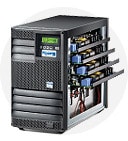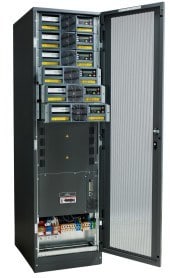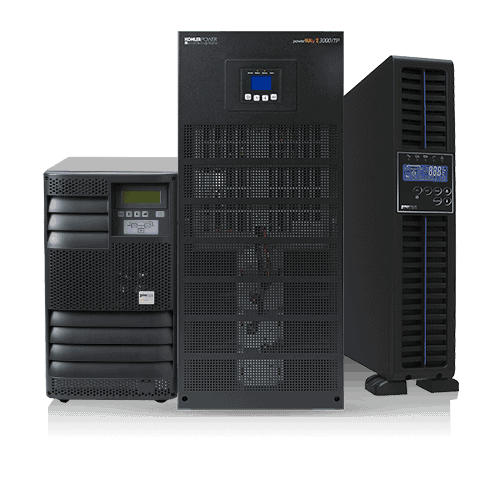Data centres have grown in popularity because they allow enterprises to locate their ever-growing and ever more critical server resource within a managed area which can be securely protected both electrically and physically. However the data centre is only part of any enterprise’s ICT resource; the rest is distributed across their operational area in the form of workstations and even local server rooms.
All this ICT equipment requires protected, clean power with availability appropriate to its particular criticality. However this criticality may vary for different areas across the site. Kenny Green, Technical Support Manager at KOHLER Uninterruptible Power Ltd, a KOHLER Company, looks at how a total but effective power protection strategy can be developed by deploying UPSs suitable for each of these distributed, varied demands for power protection.
Today, organisations generally rely on their ICT infrastructure for their daily operations and strategic decision support. For a large operation this could comprise many clusters of workstations within offices distributed throughout a site, serviced by a server room or data centre. All of this data processing equipment, together with the network hardware that allows it to communicate, must be fed with clean, uninterrupted power at all operational times. One typical power solution is to install a large UPS system which feeds the ICT equipment both within the data centre and out across the site.
However we shall see that a single system topology may not be the most cost-effective way of providing an overall, acceptable power availability solution. Although peace of mind could be secured by building the most highly available UPS solution possible, only the most highly critical load would warrant the investment required. It makes better business sense to purchase a UPS installation with availability appropriate to the site’s criticality and power requirement – and to define exactly what we mean by ‘site criticality’.
Levels of availability
The Uptime Institute has addressed this issue by defining four tiers of availability. These relate to levels of redundancy built into the data centre components and distribution paths, and act as guidelines for organisations seeking the solution most appropriate to their type of operation. For example Tier ll is appropriate for activities such as multiple-site call centres, Internet companies without onerous quality-of-service commitments or small businesses with IT requirements mostly limited to normal office hour operation. By contrast, Tier lV is typically justified for large international companies offering 24/7 online services such as e-commerce, or Internet companies with serious quality of service commitments.
Yet closer analysis of a real site could show that not all parts of its ICT infrastructure demand the same levels of availability. For example the data centre or server room could be Tier ll, whereas some offices and their workstations could be non 24/7 and less mission critical; justifying a lower level of redundancy. These offices could therefore be supplied by local, smaller and simpler UPS solutions; this reduces the load on the Tier ll data centre UPS, so reducing its size, cost and cooling requirement.
A scale of UPS solutions
Once this distributed power path has been chosen, UPS solutions can be chosen and scaled to different areas and applications across the site, ranging from single workstations to complete office networks. Micro system UPSs as small as 250 VA can be purchased, to support a single PC workstation. These are normally housed in a small mini-tower case, and blend in to an office environment much like any other PC workstation equipment. They connect into a British Standard wall mains socket and provide an IEC similar mains socket for the client PC. The backup battery is also contained within the UPS enclosure. Setting up Simple Network Management Protocol (SNMP) communications between the UPS and the computer, or automatic shutdown software, should be possible.
Larger UPS mini-systems rated from 500 – 2000 VA are also available. Like the micro systems, these are portable pieces of office equipment, however their increased rating allows them to supply a fileserver or a complete workstation comprising a PC and its peripheral equipment – apart from laser printers, which can impose harmonic distortion on the UPS output. Power connections are usually made with standard connectors. The UPS has several such connectors to accommodate the various workstation peripherals, protected by an internal circuit breaker or fuse. Normally at this power level the batteries are mounted within the UPS cabinet, but an extension battery cabinet can be added if the load requires extra battery backup (autonomy). As with the micro systems, SNMP communications or automatic shutdown software can be used as system management tools.
There are also UPS systems from 3 – 10kVA, such as the KOHLER PW 1000 and MINIPowerPLUS these are designed to support complete office networks, small server farms or communications centres rather than single workstations. They comprise installed configurations permanently wired to the mains supply rather than portable or desktop units, and larger systems may operate on 3 phase inputs and outputs. At the lower end, these systems, like the desktop examples, may have integral batteries. However as power levels climb to 15 or 20kVA, the batteries may well be housed within a separate cabinet adjacent to the UPS unit. Most UPS manufacturers offer a coordinated range of UPS and battery enclosures, imparting an aesthetic appearance to the UPS installation within a comms room.
At lower power levels within this range, the UPS may provide power through British Standard sockets like the desktop models, but in higher power systems the load will be hard wired to distribution busbars within the UPS or fed via a purpose designed distribution system. These systems will support a communications standard such as SNMP and automatic shutdown software. Most will also include remote alarm and status indication capabilities as the system is separate from individual workstations and their users.
In general, most UPS modules of any size offer either dry contact indication of status, or a network interface port, or both. This allows supervision of UPS systems and if necessary shutdown activities at both local level, and centralised level across site networks.
Medium power systems ranging from 30 to 200kVA and beyond should also be mentioned to complete the lineup, such as the KOHLER PW 5000/TP, KOHLER PW 6000 and KOHLER PW 8000DPA. However because of their capacity, size, noise levels and heat output they are more likely to be installed as a centralized resource in a plant room or data centre than out in a satellite office location.
Matching the solution to the application
Note that the level of availability can be fine tuned or profiled across a distributed system. Within each local area, modules with low kVA ratings can be paralleled for N+1 redundancy, and can support hot-swappable batteries to eliminate downtime or interruption to the load. Smaller systems can maintain downward pressure on operating as well as capital costs. High levels of efficiency are available, as well as high input power factors and low input current total harmonic distortion levels. These factors reduce costs for cooling as well as for direct energy consumption.
Clearly, using smaller systems like those above in a distributed power scheme is not practical or desirable in all situations. If an entire site is dedicated to supporting a large international 24/7 operation involving e-commerce and online transactions, then the complete UPS installation may have to be configured to Tier lV levels with redundant distribution and components. This is essential to avoid compromising the tier rating of the rest of the facility. However if some areas of ICT within the site can safely be identified as less critical to overall operation, then a distributed scheme can reduce costs by using lower but still acceptable levels of availability and protection where appropriate.







